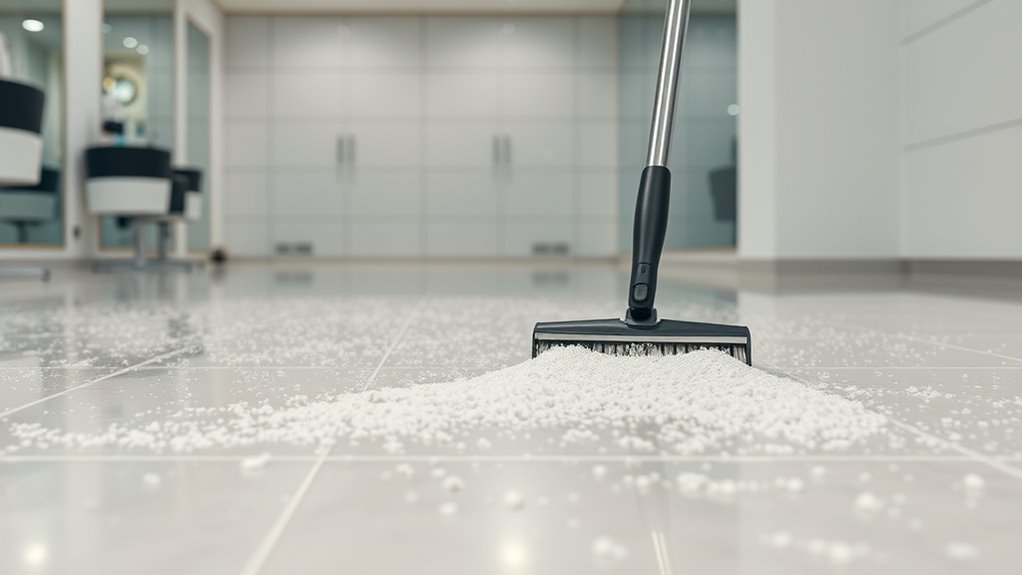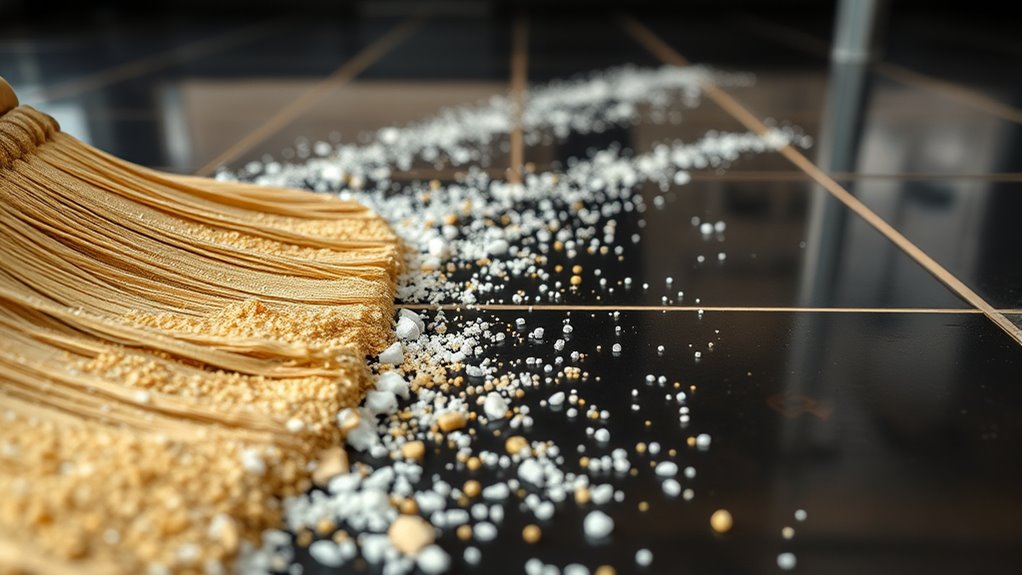To keep your salon floors scratch-free despite sand and salt, develop a consistent routine that includes damp sweeping with soft-bristled tools or microfiber mops. Use HEPA-filtered vacuums to capture fine particles early, and regularly inspect and replace worn tools to avoid damage. Dampening floors before sweeping minimizes airborne dust, while gentle motions prevent scratches. Maintaining these practices regularly helps preserve your floors’ appearance and lifespan—continue underneath to discover more tips for a flawless, professional finish.
Key Takeaways
- Use soft-bristled brooms or microfiber mops designed for delicate floors to prevent scratches when sweeping sand and salt.
- Damp mop or sweep with a slightly moist cloth to trap fine particles and reduce airborne dust settling on the surface.
- Regularly inspect and replace worn or damaged sweeping tools to avoid abrasive fibers that could scratch floors.
- Establish a consistent sweeping schedule, especially after outdoor exposure, to prevent sand and salt buildup that can cause surface damage.
- Implement dust containment methods like HEPA-filtered vacuums before sweeping to capture microscopic particles and protect flooring integrity.

Maintaining a scratch-free sweeping routine is crucial for keeping your salon floors looking pristine and professional. When you work with sand and salt, these tiny particles can easily cause surface damage if not managed properly. To prevent scratches, you need to prioritize dust control and equipment maintenance as core parts of your cleaning process. Dust control involves capturing and containing fine particles before they have a chance to settle into the floor’s surface or scratch it during sweeping. Using high-efficiency particulate air (HEPA) filters on your vacuum or dust containment systems helps trap these microscopic particles, reducing their abrasive potential. Regularly dampening the floor before sweeping also minimizes airborne dust, which can settle onto surfaces and cause scratching when disturbed by sweeping tools.
Prioritize dust control and equipment maintenance to keep floors scratch-free and professional.
Equipment maintenance plays a crucial role in ensuring your sweeping tools function effectively and safely. Worn-out brushes, broken broom fibers, or damaged dust pans can scratch the floor instead of cleaning it. Inspect your brooms and dust pans daily, replacing or repairing them as needed. Soft-bristled brooms are preferable for delicate flooring and should be used carefully to avoid scratching. When sweeping, use gentle, sweeping motions instead of aggressive scrubbing, which can lift and embed abrasive particles into the surface. Keep your equipment clean by regularly removing accumulated debris and dust from broom heads and dust pans, preventing the transfer of grit back onto the floor during use. Incorporating proper cleaning techniques helps ensure your routine remains effective and gentle on your flooring.
In addition to dust control and equipment maintenance, consider the type of sweeping tools you use. Opt for microfiber mops or soft-bristled brooms designed specifically for delicate surfaces. These tools are effective at trapping fine particles without scratching the floor, especially when combined with damp mopping techniques. Remember, the goal is to lift and contain dirt and grit without dragging abrasive particles across the surface. When working with sand and salt, be particularly cautious around the edges and corners, where debris tends to gather and can be more difficult to sweep away without causing damage.
Finally, establishing a regular sweeping schedule helps keep debris from building up and turning into a scratch hazard. Consistency ensures that sand and salt don’t accumulate to levels where they become difficult to remove safely. By integrating dust control measures, maintaining your equipment, and choosing the right tools, you create a cleaning routine that preserves your floors’ integrity and keeps your salon looking its best. A scratch-free floor not only enhances your professional appearance but also extends the lifespan of your flooring investment.
Frequently Asked Questions
How Often Should Salons Replace Their Sweeping Tools?
You should replace your sweeping tools every 3 to 6 months, depending on your sweeping schedule and how often you perform tool maintenance. Regularly inspect your brushes or brooms for wear and tear, and replace them when bristles become frayed or damaged. This guarantees effective cleaning and prevents scratches or damage to salon floors. Consistent tool maintenance and timely replacement keep your sweeping routine efficient and scratch-free.
Are There Eco-Friendly Alternatives to Sand and Salt?
Did you know that over 70% of salons seek eco-friendly options? You can switch to biodegradable abrasives and natural de-icers, which are gentle on the environment and effective for your sweeping routine. These alternatives reduce chemical runoff and waste, making your salon more sustainable. Using biodegradable abrasives and natural de-icers helps protect the planet while maintaining a scratch-free, safe workspace for your clients and staff.
Can Salt Damage Different Types of Flooring?
Yes, salt can damage certain flooring materials, especially those that aren’t salt-resistant. If you have hardwood, laminate, or vinyl floors, salt can cause discoloration, surface deterioration, or even warping over time. To protect your floors, avoid using salt on non-resistant surfaces, and opt for eco-friendly alternatives like sand or specialized ice melt products designed for sensitive flooring. Always check your flooring material’s salt resistance before applying any de-icing product.
What Are the Signs of Equipment Wear From Salt Use?
When it comes to equipment wear from salt use, look for signs like abrasive residue buildup and corrosion on metal parts. If your tools start to feel rough or show rust spots, it’s a sign you’re treading on thin ice. Regularly inspect and clean your equipment, because neglecting these signs can lead to costly repairs. Catching issues early keeps your equipment running smoothly and your salon shining bright.
How Do I Dispose of Used Salt and Sand Safely?
You should dispose of used salt and sand by exploring recycling options or proper disposal methods. Check with local waste management facilities to see if they accept these materials for recycling or safe disposal. Avoid dumping them in drains or onto the ground, as this can cause environmental harm. Instead, store used materials in sealed containers and follow your community’s guidelines for disposal, ensuring you’re environmentally responsible.
Conclusion
By adopting this sand and salt sweeping routine, you’ll keep your salon floors scratch-free and spotless. It might seem like extra effort at first, but the benefits outweigh the hassle—your floors stay pristine longer, saving you time and money. Don’t let concerns about mess or effort hold you back; once you get into the habit, it becomes quick and easy. Enjoy a cleaner, safer salon environment that impresses clients and keeps your space looking professional.








